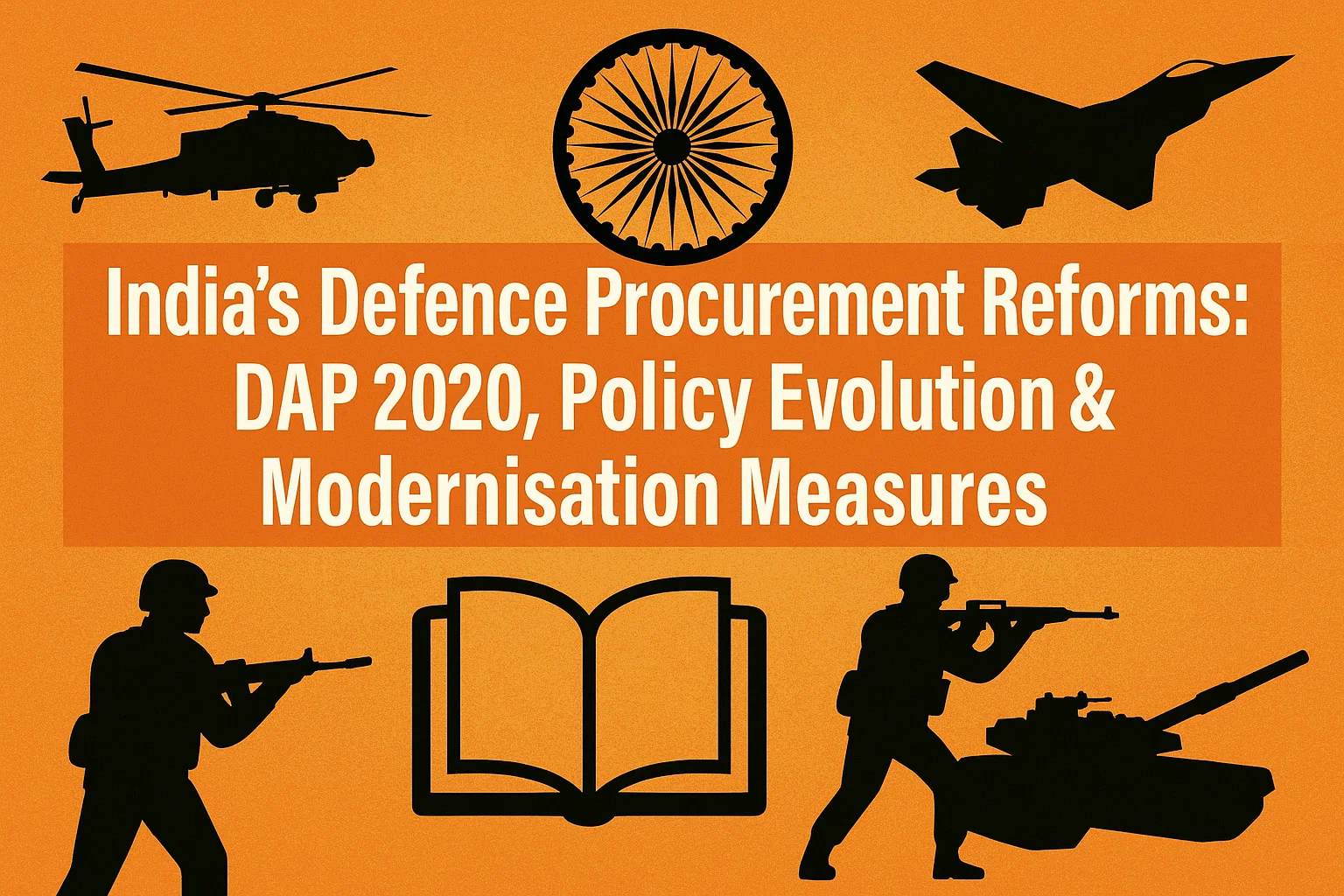India’s Defence Procurement Reforms: DAP 2020, Policy Evolution & Modernisation Measures
India’s Defence Acquisition Procedure (DAP) 2020 aims to modernise military procurement through transparency and self-reliance. Learn how India’s defence procurement evolved, the role of the Defence Acquisition Council, key challenges in implementation, and global lessons to make acquisition faster, agile, and innovation-driven.
India’s Defence Procurement Reforms:
Defence procurement is a critical determinant of a nation’s military preparedness and strategic autonomy. In India, this process has long been hampered by complexity and delays, undermining the military’s operational readiness even as regional adversaries modernize rapidly.
What is the current status?
- The Defence Acquisition Procedure (DAP) 2020 is the current governing framework, designed to harmonise transparency, accountability, and the vision of ‘Atmanirbhar Bharat’ (self-reliance).
- However, its sequential, compliance-heavy design often acts as a deterrent, stretching procurement cycles to 7-10 years.
- Globally, trends are shifting towards agile, outcome-oriented models, as exemplified by the US SPEED Act 2025, which prioritises speed and innovation.

What is the Defence Procurement Policy?
- The Defence Procurement Policy is the comprehensive set of guidelines and procedures governing how the Indian Armed Forces acquire new weapons, platforms, and equipment.
- Its primary objective is to ensure the military is equipped with modern technology in a timely and cost-effective manner while ensuring transparency, probity, and the promotion of indigenous defence manufacturing.
- The current incarnation of this policy is the Defence Acquisition Procedure (DAP) 2020. It outlines the entire journey from identifying a military need to the final induction and lifecycle support of a defence asset.
How has it evolved in India?
India’s defence procurement policy has evolved significantly from a largely ad-hoc, import-dependent system to a more structured one aimed at self-reliance:
- Pre-2000s: Characterised by single-vendor, import-heavy deals with limited focus on transparency or indigenous capacity.
- 2002 – First DPP: The first formal Defence Procurement Procedure (DPP) was introduced, bringing structure and emphasising transparency through multi-vendor competition.
- Subsequent Revisions (2005, 2006, 2008, 2011, 2013, 2016): Each iteration introduced new concepts. Key milestones included:
- Introducing the ‘Buy Global’ and ‘Buy and Make’ categories.
- Strengthening the ‘Make’ procedure for indigenous design and development.
- Introducing the ‘Strategic Partnership’ model to create capacity in the private sector.
- 2020 – DAP: The Defence Acquisition Procedure 2020 marked a significant shift, rebranding from “Procurement” to “Acquisition” to reflect a more holistic lifecycle approach. Its cornerstone is the prioritisation of ‘Buy (Indian-IDDM)’ – Indigenously Designed, Developed and Manufactured – as the most preferred category, firmly anchoring the policy to the Atmanirbhar Bharat vision.
What is the role of the Defence Acquisition Council?
The Defence Acquisition Council (DAC) is the highest decision-making body for defence procurement in India. Chaired by the Raksha Mantri (Defence Minister), its primary roles are:
- Granting ‘Acceptance of Necessity’ (AoN): The DAC approves the initial need for any capital acquisition, validating the operational requirement and its alignment with long-term plans before the procurement process formally begins.
- Policy Formulation: It provides overall guidance and approves all changes and updates to the Defence Acquisition Procedure (DAP).
- Clearing High-Value Projects: It oversees and approves major defence projects, especially those with strategic importance or significant financial implications.
- Ensuring Inter-Service Synergy: By bringing together the highest echelons of the Ministry of Defence and the Armed Forces, the DAC ensures that acquisitions are aligned with India’s integrated defence strategy.
What are the major challenges of India’s Defence Procurement Policy?
Despite reforms, DAP 2020 faces several structural challenges:
- Protracted Timelines: The sequential, multi-layered process (RFI -> AoN -> RFP -> Trials -> CNC) often leads to a time-to-field of 7-10 years, by which time the technology may be obsolete.
- Complexity and Bureaucracy: A compliance-heavy, document-centric approach creates bureaucratic inertia, diffuses accountability, and discourages participation, especially from agile start-ups and MSMEs.
- Rigid Requirements: Service Qualitative Requirements (SQRs) are often overly rigid and specification-driven, stifling innovation and locking out alternative solutions that may better meet the core capability gap.
- Limited Indigenous Depth: While ‘Make in India’ is a priority, the policy often struggles to translate this into high-value indigenous manufacturing due to a narrow industrial base, technology gaps, and challenges in executing ‘Strategic Partnerships’ and ‘Make’ projects.
- Blacklisting and Risk-Aversion: Past issues with vendors have led to a risk-averse culture, where the fear of procedural violations can paralyse decision-making.
What measures can be taken to address these challenges?
To build a faster, more responsive acquisition system, India can consider the following measures, drawing from global best practices like the US SPEED Act:
- Shift from Sequential to Concurrent Processing: Adopt an iterative, outcome-oriented process where cost estimation, technical feasibility, and vendor identification happen concurrently, not sequentially, to compress timelines.
- Empower Decision-Makers: Implement a Programme Executive Officer (PEO) model, vesting end-to-end responsibility and financial authority in dedicated officers to accelerate Contract Negotiation Committees (CNCs) and lifecycle management.
- Reform Requirements Framing: Replace rigid SQRs with outcome-based briefs framed by a Joint Requirements Council comprising all services. This would focus on the ‘what’ (capability) rather than the ‘how’ (specifications), fostering innovation.
- Streamline Trials and Testing: Merge technical and field trials into Integrated Project Teams (IPTs) using digital simulations and prototype-first testing to reduce duplication and cut trial timelines from years to months.
- Adopt Agile Contracting Pathways: Introduce flexible mechanisms like Other Transaction Authorities (OTAs) to onboard non-traditional vendors and accelerate prototyping, moving beyond standard, rigid contracts.
- Embrace Digital Governance: Replace paper-driven files with real-time digital dashboards for oversight, ensuring transparency while enabling speed.
Subscribe to our Youtube Channel for more Valuable Content – TheStudyias
Download the App to Subscribe to our Courses – Thestudyias
The Source’s Authority and Ownership of the Article is Claimed By THE STUDY IAS BY MANIKANT SINGH




